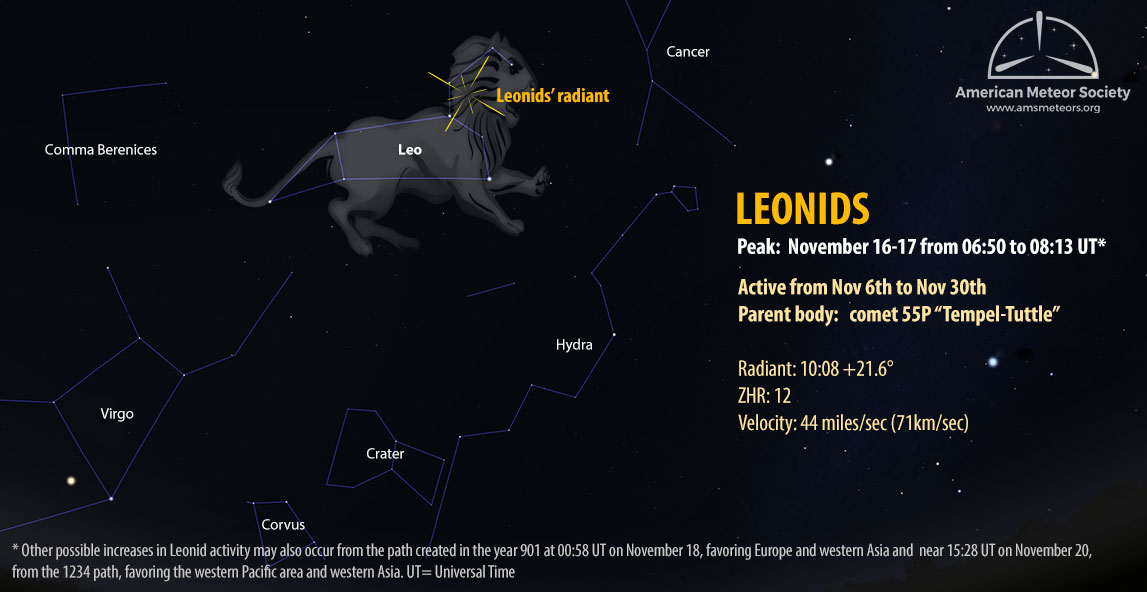 Paul Sutherland captured this Leonid fireball from Walmer, Kent, England, on 19 November 2017 at 02h29m09s UT. Credit Paul Sutherland .
Paul Sutherland captured this Leonid fireball from Walmer, Kent, England, on 19 November 2017 at 02h29m09s UT. Credit Paul Sutherland .The Leonids are active all of November but only produce strong rates near the date of maximum activity. In 2020, that date will be the night of November 16-17. No major outbursts are predicted this year but the Leonids are impressive meteors regardless of the numbers seen. Many Leonids meteors are bright and colorful, often leaving long-lasting persistent trains visible in the sky after the meteor has disappeared. Realistic hourly rates at maximum are probably near 10. Expect to see the highest activity only during the last couple of hours prior to dawn on November 17th. Should this morning be overcast, the morning of the 18th should present nearly as much activity.
The Leonids are remnants of comet 55P Tempel-Tuttle, which last passed through the inner solar system in 1998. The comet has just passed its farthest point from the sun and is now on its inbound leg of its journey around the sun. It is expected to be closest to the sun again in 2031. The comet has completed so many trips around the sun that remnants are encountered on Earth every November, regardless of the position of the comet. Each journey around the sun produces its own unique path and the Earth often passes close to this paths each year. In 2020, we are predicted to pass close to the path created in the year 1600 between 06:50 and 08:13 universal time (UT) on November 17. A slight increase of faint Leonid activity may occur in this time span, which is favorable for North and South America. Other possible increases in Leonid activity may also occur from the path created in the year 901 at 00:58 UT on November 18, favoring Europe and western Asia and near 15:28 UT on November 20, from the 1234 path, favoring the western Pacific area and western Asia.*
The source (radiant) of the Leonid meteors lies in the “sickle” of Leo near the star named Algieba (gamma Leonis). This area of the sky rises in the east between 23:00 and midnight for most of the world. Therefore no Leonid meteors may be seen during the early evening hours when the source lies far below the horizon. As the midnight hour approaches some Leonid activity may be seen shooting upwards from the eastern horizon. The best views of this display occurs during the last two hours prior to dawn when the source lies highest above the horizon in a dark sky. Leonid meteor may be seen in any portion of the sky but it would be wise to concentrate your view in the eastern half where Leonid meteors can be seen shooting in all directions. Luckily, the Leonid meteors may be seen in both hemispheres but the northern hemisphere is favored by the source being located higher in the sky and a longer night this time of year.

Viewing meteor activity is a great way to easily contribute to science by being a citizen scientist. In order to produce scientifically useful data you need to view for at least one hour and provide shower associations with each meteor you witness. It also is necessary to provide us with the magnitude of the faintest star you can see. This is easily done by counting the number of stars visible with certain areas of the sky – see also https://www.imo.net/observations/methods/visual-observation/ and here for more tips on viewing meteor showers. In order to share your observations we suggest that you fill out a visual meteor report form provided by the International Meteor Organization. We wish you good luck and look forward to seeing your viewing results!
*Reference: 2020 Meteor Shower Calendar By Juergen Rendtel, pages 17-18. https://www.imo.net/files/meteor-shower/cal2020.pdf
 American Meteor Society
American Meteor Society
Thank you for using my photo of the Leonid fireball! If anyone is interested, I have images of the subsequent drifting train, including an animation, on my own website. https://www.skymania.com/wp/all-about-leonid-meteor-shower/ The train was still visible more than 30 minutes after the event.
I seen this